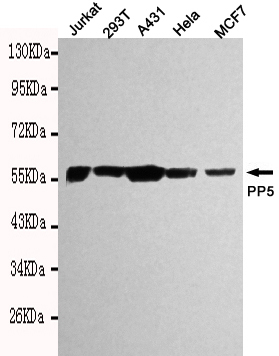PP5 Antibody
Purified Mouse Monoclonal Antibody (Mab)
- 产品详情
- 实验流程
- 背景知识
Application
| WB |
|---|---|
| Primary Accession | P53041 |
| Reactivity | Human |
| Host | Mouse |
| Clonality | Monoclonal |
| Isotype | IgG2a |
| Calculated MW | 56879 Da |
| Gene ID | 5536 |
|---|---|
| Other Names | FLJ36922;FLJ55954;OTTHUMP00000165834;PP-T;PP5;PPP5;PPP5_HUMAN;PPP5C;PPT;Protein phosphatase 5, catalytic subunit;Protein phosphatase T;Serine/threonine protein phosphatase 5;Serine/threonine-protein phosphatase 5. |
| Dilution | WB~~1:1000 |
| Format | Liquid in PBS containing 50% glycerol, 0.5% BSA and 0.02% sodium azide, pH 7.3. |
| Storage | Store at 4°C short term. Aliquot and store at -20°C long term. Avoid freeze/thaw cycles. |
| Name | PPP5C |
|---|---|
| Synonyms | PPP5 |
| Function | Serine/threonine-protein phosphatase that dephosphorylates a myriad of proteins involved in different signaling pathways including the kinases CSNK1E, ASK1/MAP3K5, PRKDC and RAF1, the nuclear receptors NR3C1, PPARG, ESR1 and ESR2, SMAD proteins and TAU/MAPT (PubMed:14734805, PubMed:14764652, PubMed:14871926, PubMed:15383005, PubMed:15546861, PubMed:16260606, PubMed:16790549, PubMed:16892053, PubMed:19176521, PubMed:19948726, PubMed:21144835, PubMed:22399290, PubMed:22781750, PubMed:23102700, PubMed:30699359, PubMed:9000529). Implicated in wide ranging cellular processes, including apoptosis, differentiation, DNA damage response, cell survival, regulation of ion channels or circadian rhythms, in response to steroid and thyroid hormones, calcium, fatty acids, TGF-beta as well as oxidative and genotoxic stresses (PubMed:14734805, PubMed:14764652, PubMed:14871926, PubMed:15383005, PubMed:15546861, PubMed:16260606, PubMed:16790549, PubMed:16892053, PubMed:19176521, PubMed:19948726, PubMed:21144835, PubMed:22399290, PubMed:22781750, PubMed:23102700, PubMed:30699359, PubMed:9000529). Participates in the control of DNA damage response mechanisms such as checkpoint activation and DNA damage repair through, for instance, the regulation ATM/ATR-signaling and dephosphorylation of PRKDC and TP53BP1 (PubMed:14871926, PubMed:16260606, PubMed:21144835). Inhibits ASK1/MAP3K5-mediated apoptosis induced by oxidative stress (PubMed:23102700). Plays a positive role in adipogenesis, mainly through the dephosphorylation and activation of PPARG transactivation function (By similarity). Also dephosphorylates and inhibits the anti- adipogenic effect of NR3C1 (By similarity). Regulates the circadian rhythms, through the dephosphorylation and activation of CSNK1E (PubMed:16790549). May modulate TGF-beta signaling pathway by the regulation of SMAD3 phosphorylation and protein expression levels (PubMed:22781750). Dephosphorylates and may play a role in the regulation of TAU/MAPT (PubMed:15546861). Through their dephosphorylation, may play a role in the regulation of ions channels such as KCNH2 (By similarity). Dephosphorylate FNIP1, disrupting interaction with HSP90AA1/Hsp90 (PubMed:30699359). |
| Cellular Location | Nucleus. Cytoplasm. Cell membrane. Note=Predominantly nuclear (PubMed:15383005). But also present in the cytoplasm (PubMed:15383005) Translocates from the cytoplasm to the plasma membrane in a RAC1- dependent manner (PubMed:19948726). |
| Tissue Location | Ubiquitous.. |
For Research Use Only. Not For Use In Diagnostic Procedures.
Provided below are standard protocols that you may find useful for product applications.
BACKGROUND
Serine/threonine-protein phosphatase that dephosphorylates a myriad of proteins involved in different signaling pathways including the kinases CSNK1E, ASK1/MAP3K5, PRKDC and RAF1, the nuclear receptors NR3C1, PPARG, ESR1 and ESR2, SMAD proteins and TAU/MAPT. Implicated in wide ranging cellular processes, including apoptosis, differentiation, DNA damage response, cell survival, regulation of ion channels or circadian rhythms, in response to steroid and thyroid hormones, calcium, fatty acids, TGF-beta as well as oxidative and genotoxic stresses. Participates in the control of DNA damage response mechanisms such as checkpoint activation and DNA damage repair through, for instance, the regulation ATM/ATR-signaling and dephosphorylation of PRKDC and TP53BP1. Inhibits ASK1/MAP3K5-mediated apoptosis induced by oxidative stress. Plays a positive role in adipogenesis, mainly through the dephosphorylation and activation of PPARG transactivation function. Also dephosphorylates and inhibits the anti-adipogenic effect of NR3C1. Regulates the circadian rhythms, through the dephosphorylation and activation of CSNK1E. May modulate TGF-beta signaling pathway by the regulation of SMAD3 phosphorylation and protein expression levels. Dephosphorylates and may play a role in the regulation of TAU/MAPT. Through their dephosphorylation, may play a role in the regulation of ions channels such as KCNH2.
REFERENCES
Kalnine N.,et al.Submitted (MAY-2003) to the EMBL/GenBank/DDBJ databases.
Mural R.J.,et al.Submitted (JUL-2005) to the EMBL/GenBank/DDBJ databases.
Chen M.X.,et al.EMBO J. 13:4278-4290(1994).
Yong W.H.,et al.Genomics 29:533-536(1995).
Grimwood J.,et al.Nature 428:529-535(2004).
终于等到您。ABCEPTA(百远生物)抗体产品。
点击下方“我要评价 ”按钮提交您的反馈信息,您的反馈和评价是我们最宝贵的财富之一,
我们将在1-3个工作日内处理您的反馈信息。
如有疑问,联系:0512-88856768 tech-china@abcepta.com.























 癌症的基本特征包括细胞增殖、血管生成、迁移、凋亡逃避机制和细胞永生等。找到癌症发生过程中这些通路的关键标记物和对应的抗体用于检测至关重要。
癌症的基本特征包括细胞增殖、血管生成、迁移、凋亡逃避机制和细胞永生等。找到癌症发生过程中这些通路的关键标记物和对应的抗体用于检测至关重要。 为您推荐一个泛素化位点预测神器——泛素化分析工具,可以为您的蛋白的泛素化位点作出预测和评分。
为您推荐一个泛素化位点预测神器——泛素化分析工具,可以为您的蛋白的泛素化位点作出预测和评分。 细胞自噬受体图形绘图工具为你的蛋白的细胞受体结合位点作出预测和评分,识别结合到自噬通路中的蛋白是非常重要的,便于让我们理解自噬在正常生理、病理过程中的作用,如发育、细胞分化、神经退化性疾病、压力条件下、感染和癌症。
细胞自噬受体图形绘图工具为你的蛋白的细胞受体结合位点作出预测和评分,识别结合到自噬通路中的蛋白是非常重要的,便于让我们理解自噬在正常生理、病理过程中的作用,如发育、细胞分化、神经退化性疾病、压力条件下、感染和癌症。






